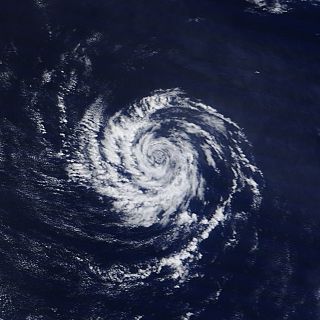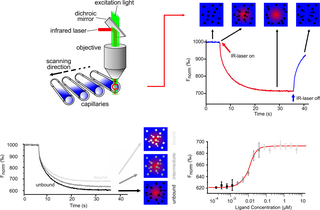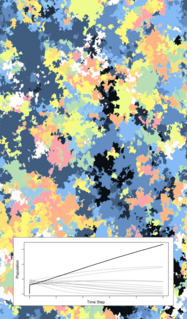Microelectronics is a subfield of electronics. As the name suggests, microelectronics relates to the study and manufacture of very small electronic designs and components. Usually, but not always, this means micrometre-scale or smaller. These devices are typically made from semiconductor materials. Many components of normal electronic design are available in a microelectronic equivalent. These include transistors, capacitors, inductors, resistors, diodes and (naturally) insulators and conductors can all be found in microelectronic devices. Unique wiring techniques such as wire bonding are also often used in microelectronics because of the unusually small size of the components, leads and pads. This technique requires specialized equipment and is expensive.
In fluid dynamics, turbulence or turbulent flow is fluid motion characterized by chaotic changes in pressure and flow velocity. It is in contrast to a laminar flow, which occurs when a fluid flows in parallel layers, with no disruption between those layers.
Microtechnology is technology with features near one micrometre. It focuses on physical and chemical processes as well as the production or manipulation of structures with one-micrometre magnitude.
Kolmogorov microscales are the smallest scales in turbulent flow. At the Kolmogorov scale, viscosity dominates and the turbulent kinetic energy is dissipated into heat. They are defined by

A coordinate measuring machine (CMM) is a device that measures the geometry of physical objects by sensing discrete points on the surface of the object with a probe. Various types of probes are used in CMMs, including mechanical, optical, laser, and white light. Depending on the machine, the probe position may be manually controlled by an operator or it may be computer controlled. CMMs typically specify a probe's position in terms of its displacement from a reference position in a three-dimensional Cartesian coordinate system. In addition to moving the probe along the X, Y, and Z axes, many machines also allow the probe angle to be controlled to allow measurement of surfaces that would otherwise be unreachable.

Mesoscale meteorology is the study of weather systems smaller than synoptic scale systems but larger than microscale and storm-scale cumulus systems. Horizontal dimensions generally range from around 5 kilometers to several hundred kilometers. Examples of mesoscale weather systems are sea breezes, squall lines, and mesoscale convective complexes.
Micro heat exchangers,Micro-scale heat exchangers, or microstructured heat exchangers are heat exchangers in which fluid flows in lateral confinements with typical dimensions below 1 mm. The most typical such confinement are microchannels, which are channels with a hydraulic diameter below 1 mm. Microchannel heat exchangers can be made from metal, ceramic,
Thermophoresis is a phenomenon observed in mixtures of mobile particles where the different particle types exhibit different responses to the force of a temperature gradient. The term thermophoresis most often applies to aerosol mixtures, but may also commonly refer to the phenomenon in all phases of matter. The term Soret effect normally applies to liquid mixtures, which behave according to different, less well-understood mechanisms than gaseous mixtures. Thermophoresis may not apply to thermomigration in solids, especially multi-phase alloys.
Microscale chemistry is an analytical method and also a teaching method widely used at school and at university levels, working with small quantities of chemical substances. While much of traditional chemistry teaching centers on multi-gramme preparations, milligrammes of substances are sufficient for microscale chemistry. In universities, modern and expensive lab glassware is used and modern methods for detection and characterization of the produced substances are very common. In schools and in many countries of the Southern hemisphere, small-scale working takes place with low-cost and even no-cost material. There has always been a place for small-scale working in qualitative analysis, but the new developments can encompass much of chemistry a student is likely to meet.
Microscale meteorology is the study of short-lived atmospheric phenomena smaller than mesoscale, about 1 km or less. These two branches of meteorology are sometimes grouped together as "mesoscale and microscale meteorology" (MMM) and together study all phenomena smaller than synoptic scale; that is they study features generally too small to be depicted on a weather map. These include small and generally fleeting cloud "puffs" and other small cloud features. Microscale meteorology controls the most important mixing and dilution processes in the atmosphere. Important topics in microscale meteorology include heat transfer and gas exchange between soil, vegetation, and/or surface water and the atmosphere caused by near-ground turbulence. Measuring these transport processes involves use of micrometeorological towers. Variables often measured or derived include net radiation, sensible heat flux, latent heat flux, ground heat storage, and fluxes of trace gases important to the atmosphere, biosphere, and hydrosphere.

The Wingless Electromagnetic Air Vehicle (WEAV) was a heavier than air flight system developed at the University of Florida, funded by the Air Force Office of Scientific Research. The WEAV was invented in 2006 by Dr. Subrata Roy, plasma physicist, aerospace engineering professor at the University of Florida, and has been a subject of several patents. The WEAV employs no moving parts, and combines the aircraft structure, propulsion, energy production and storage, and control subsystems into one integrated system.
The Taylor microscale, which is sometimes called the turbulence length scale, is a length scale used to characterize a turbulent fluid flow. This microscale is named after Geoffrey Ingram Taylor. The Taylor microscale is the intermediate length scale at which fluid viscosity significantly affects the dynamics of turbulent eddies in the flow. This length scale is traditionally applied to turbulent flow which can be characterized by a Kolmogorov spectrum of velocity fluctuations. In such a flow, length scales which are larger than the Taylor microscale are not strongly affected by viscosity. These larger length scales in the flow are generally referred to as the inertial range. Below the Taylor microscale the turbulent motions are subject to strong viscous forces and kinetic energy is dissipated into heat. These shorter length scale motions are generally termed the dissipation range.
The Batchelor scale, determined by George Batchelor (1954), describes the size of a droplet of scalar that will diffuse in the same time it takes the energy in an eddy of size η to dissipate. The Batchelor scale can be determined by:

Microscale thermophoresis (MST) is a technology for the biophysical analysis of interactions between biomolecules. Microscale thermophoresis is based on the detection of a temperature-induced change in fluorescence of a target as a function of the concentration of a non-fluorescent ligand. The observed change in fluorescence is based on two distinct effects. On the one hand it is based on a temperature related intensity change (TRIC) of the fluorescent probe, which can be affected by binding events. On the other hand it is based on thermophoresis, the directed movement of particles in a microscopic temperature gradient. Any change of the chemical microenvironment of the fluorescent probe, as well as changes in the hydration shell of biomolecules result in a relative change of the fluorescence detected when a temperature gradient is applied and can be used to determine binding affinities. MST allows measurement of interactions directly in solution without the need of immobilization to a surface.
An impedance pump is a valveless pump consisting of an elastic tube connected on both ends to an inelastic tube. Tapping the end of a tube will cause flow of liquid inside the system.
Micro armour refers to small figurines made of lead, pewter, die cast metal or plastic, usually used for wargaming purposes. Variations of the name include: mini armour, microscale, mini tanks, miniature armour, miniature tanks, micro tanks, minitanks, minifigs, armour figurines, tank figurines, etc. are also used. Micro armour is a sub-category of model military vehicle miniature figures used for military simulation, miniature wargaming, scale models, dioramas and collecting.
Equation-free modeling is a method for multiscale computation and computer-aided analysis. It is designed for a class of complicated systems in which one observes evolution at a macroscopic, coarse scale of interest, while accurate models are only given at a finely detailed, microscopic, level of description. The framework empowers one to perform macroscopic computational tasks using only appropriately initialized microscopic simulation on short time and small length scales. The methodology eliminates the derivation of explicit macroscopic evolution equations when these equations conceptually exist but are not available in closed form; hence the term equation-free.

Microscale models form a broad class of computational models that simulate fine-scale details, in contrast with macroscale models, which amalgamate details into select categories. Microscale and macroscale models can be used together to understand different aspects of the same problem.
Mesoscale manufacturing is the process of creating components and products in a range of approximately from 0.1mm to 5mm with high accuracy and precision using a wide variety of engineering materials. Mesomanufacturing processes are filling the gap between macro- and micromanufacturing processes and overlaps both of them.. Other manufacturing technologies are nanoscale, microscale and macroscale manufacturing.




